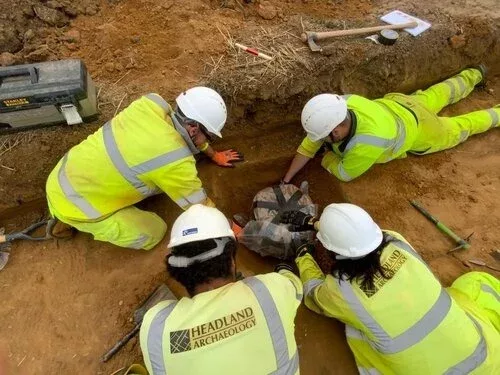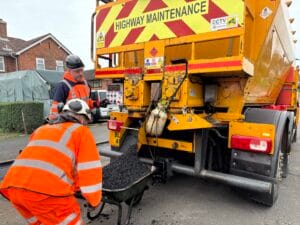A possible Romano-British settlement, Bronze Age cremations and a prehistoric millstone are among the early archaeological discoveries that National Highways has made while unearthing 10,000 years of human history along the A12 Chelmsford to A120 widening scheme in Essex.
As part of the proposed scheme, National Highways (formerly known as Highways England) excavated a series of archaeological trial trenches to learn more about what life was like in the area during early prehistoric period through to post medieval times.
Over the last five months, National Highways team of over 80 archaeologists investigated an area of 1039 hectare – the equivalent of around 1,445 full sized football pitches. This involved excavating and surveying 2,117 trial trenches.
Trial trenching is a method of archaeological evaluation used to characterise and determine the archaeological potential of a site. A mechanical excavator is used to trenches to expose archaeological features deposits and any archaeology encountered is excavated by hand and recorded. The results of the trial trenching are used to inform any future stage of work.
Stephen Elderkin, National Highways Project Director, said: “The work we are doing along the A12 route aims to unearth archaeological sites and finds that will help shape our understanding of how life in Essex and beyond has developed through 10,000 years of human history.
“A good, early understanding of the unique relationship between the improvement scheme and the surrounding historical environment will help us avoid any unexpected surprises and unnecessary delays once construction begins.
“This is all part of the work we’re doing to respect the area’s cultural heritage while we deliver the vital upgrade that will improve journeys for up to 90,000 people every day.”
The A12 Chelmsford to A120 widening scheme is located within a rich archaeological landscape, with evidence dating up to 10,000 years ago right through to the modern day. By analysing early historical records and digging more than 2000 trial trenches, the archaeological consultants and contractors for National Highways made some interesting finds:
Evidence of numerous ditches, refuse pits and postholes indicated a Romano-British settlement.
Other Romano-British items identified included pottery, consistent with storage jars which would have been used to store wine, milk and vinegar.
‘Samian Ware’ was also found, a type of valuable tableware glazed to a bright red-brown glow and often decorated ornately with pastoral, mythological or pornographic themes.
Sites across the route revealed evidence of building materials including fired clay daub and the remains of both an ‘imbrex’, a raised Roman roofing tile, and a ‘tegulae’, a flat Roman roofing tile.
Recovery of animal bones, including the remains of horses, cows, sheep, goats and rabbits gives an insight into the ancient diets. There was also evidence of emmer, the main cereal grown and consumed in the Bronze and Iron Ages and an ancient millstone.
The archaeological evidence will be combined to produce a report, which will provide site-by-site information on the excavations and ultimately inform the next stages of archaeological work. These later stages may comprise bespoke packages of large-scale archaeological excavation ahead of the construction works or archaeological monitoring during the works themselves.
The A12 is a key economic route through Essex and Suffolk, connecting London with Ipswich and the Port of Felixstowe. The section between Chelmsford and Colchester carries high volumes of traffic, with up to 90,000 vehicles every day. Heavy goods vehicles are between 9% and 12% of the traffic on this section due to its important freight connection.
Upgrading the A12 between junctions 19 and 25 to three lanes will help with economic growth of the region and keep the country connected. The upgraded road will improve safety by connecting local roads via new junctions rather than turning directly onto the A12, and increase capacity, making journey times shorter and more reliable.
Once complete by the end of 2028, the improved A12 will reduce journey times by up to 12 minutes for the 90,000 drivers who use it daily.

























